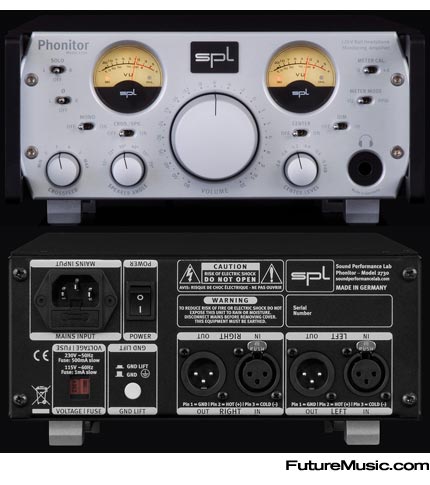SPL Phonitor
I've listened to just about every cross-feed circuit out there. I've twiddled and tweaked long hours to make it do it's thing and not get in the way of fidelity. It's not easy. But the SPL Phonitor just blew me away with its outstanding and fully adjustable cross-feed circuit.
Doing cross-feed well is very difficult. It tends to murk up the sound a bit. Any common bass information on both channels tends to build up when summed back on itself in the opposite channel, which results in a slight warming of the sound. Not so with the Phonitor. I spent a good deal of time playing with the cross-feed adjustments on this amp and I simply couldn't perceive any tonal changes while diddling.
Hearing cross-feed changes is difficult, the results are subtle and it takes a trained ear to tell what's going on. An easy way to listen to the effects of a cross-feed circuit is to remove either the left or right input to the amp and listen to the resulting display of what one channel is doing. When I did so on the Phonitor in order to be able to hear clearly what the device was doing I was immensely pleased to hear exactly what I would like to hear with such a circuit.
The Phonitor (~$2000) has adjustments for speaker angle (time delay), cross-feed level (how much signal is mixed into the opposite channel), and center image (L+R level). Having made a similar experimental unit when first playing around with cross-feed circuits, I can tell you that SPL must have done some very cool things inside their box in order to pull of this trick and still leave the music clean and clear.
There's a lot of contention in Headphonedom about whether cross-feed is needed or not to create a convincing audio image. Many claim that their head becomes accustom to the sound of headphones and have no problem hearing a solid image. I disagree. Having an inter-aural time difference (ITD is the arrival time difference from off-axis sounds at the ears) is fundamental to left-to-right aural localization (sometimes called lateralization). I think the lack of belief that cross-talk circuits are valuable for headphone listening is fundamentally due to the fact that all such circuits I've heard in the past either don't technically achieve the correct delay and mix of the cross-talk signal, or end up changing the tonality of the music.
I think the Phonitor may change all that. My experience was that I was able to adjust the cross-feed circuit in this amp easily, and was able to develop a very natural and organically correct listening experience without changing the tonality of the music one little bit. Just extraordinary.
I'd have to have some listening time here at home to comment on the clarity and articulation of this amp, but on first listen it seemed very good. I'd highly recommend that folks looking for better imaging on headphones have a listen to the Phonitor and it's excellent cross-feed circuit.
Edit: I should add that I don't consider the Smyth Realizer a cross-feed circuit. It's a very complicated, DSP-based, HRTF (head related transfer function) generator that does an even better job of producing a realistic headphone image presentation, but is far more ambitious and complicated a device.







